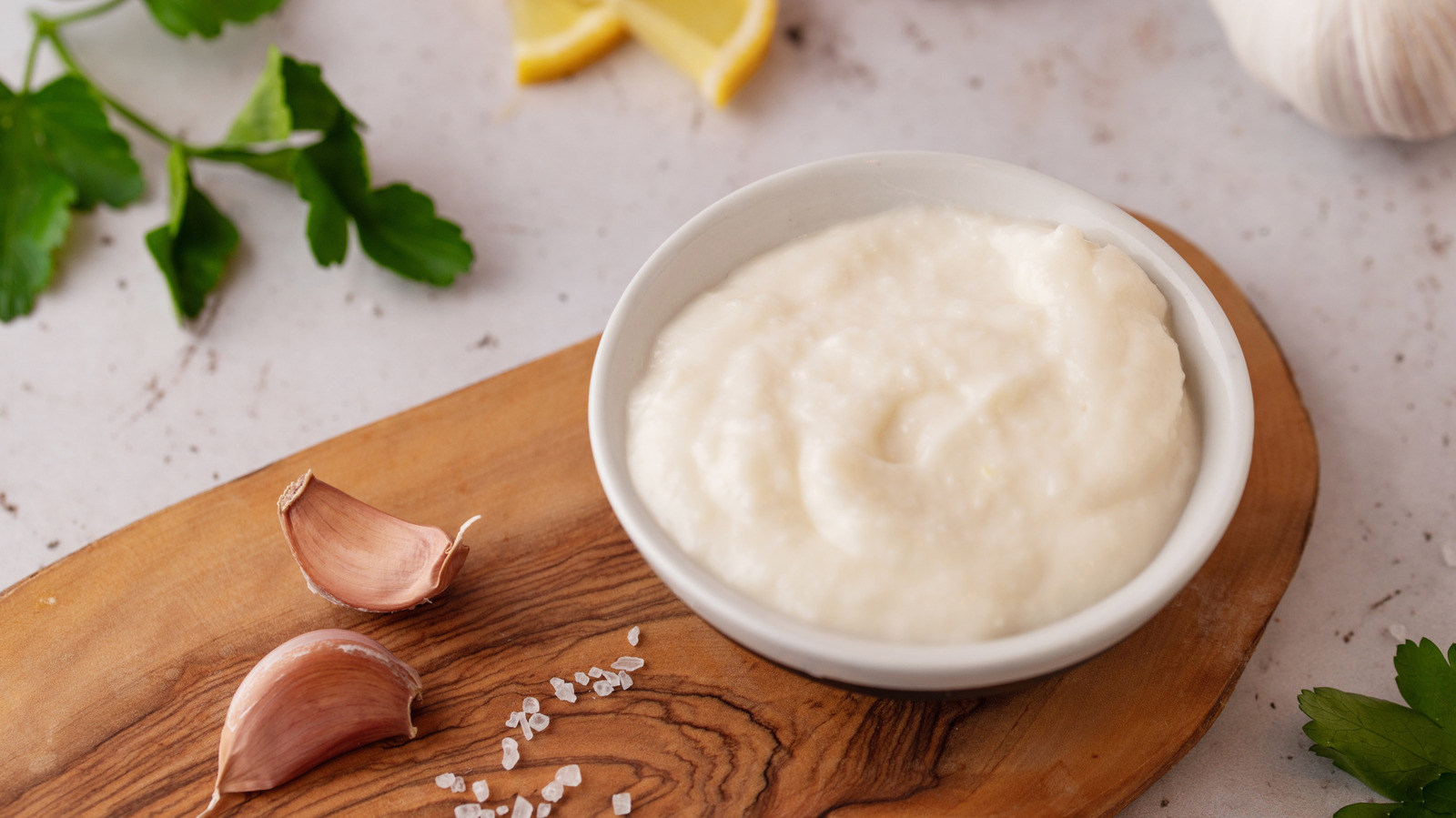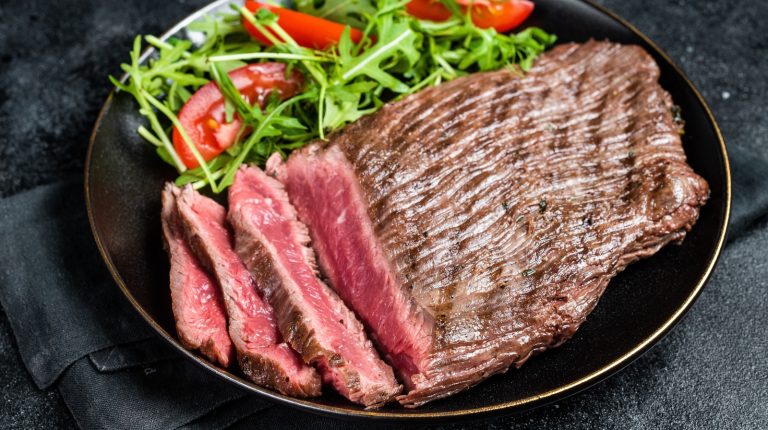At the beginning of my career in Europe, I interned on a farm in southern France, which is claimed to be the land of aioli. I worked in a tiny kitchen for around one month alongside the head chef and a dachshund that lingered around the kitchen. At this time viewpoint of aioli was skewed being from the States since I believed this sauce was either eggs or dairy-based — however, I was wrong. When I first watched aioli being made I was amazed. Raw garlic was transformed by a slow drizzle of olive oil and a consistent pressing motion of pestle — turning it into a fluffy, velvety sauce.
It’s pretty easy to get this sauce confused with its distant cousin, mayonnaise. The main difference between these two sauces is the inclusion of garlic in the aioli. Aioli is traditionally made from emulsion of garlic and olive oil. While mayonnaise is made from emulsifying oil, egg yolk, and an acid like lemon juice or vinegar.
The exact origin of aioli is disputed, but it likely emerged from the region of southern France or eastern Spain— undoubtedly this sauce is quintessentially Mediterranean. Traditionally, aioli is made with mortar and pestle, but you can get it by just using a food processor. Be sure to use fresh garlic and high-quality olive oil since they are the main flavor profile of the sauce. To switch it up try using one of these 15 ingredients to take this sauce to the next level!
1. Calabrian chili paste
Craving a bit of spice in your aioli? Add a teaspoon of this Italian chili paste and be transported to the fiery land of the Calabrian peninsula. For those who haven’t experienced the magical ingredient that is Calabrian chili paste, it delivers an extremely spicy flavor tempered by hints of vinegar and the comforting taste of olive oil. Once incorporated into a rich, garlicky aioli, the chili paste adopts an almost fruity and smoky profile. This spicy aioli would be an excellent topping for grilled lamb chops or even for enlivening pasta sauces like Bolognese or amatriciana, contributing a creamy, fiery flavor. If you are a sandwich aficionado try mixing it with some mayonnaise and use it as a spread.
Be sure you’re using the paste, not a whole pepper, as its heat ranges from 25,000 to 40,000 Scoville units. The paste is slightly milder due to the inclusion of vinegar and olive oil. For reference, a jalapeño measures 2,500 to 8,000 Scoville units, so consider using a chopped jalapeño if you prefer a milder heat.
2. Yuzu kosho
Anytime you’re making an aioli, adding a hint of acidity is always wise to complement the garlic and balance the creaminess. There are plenty of ingredients to choose from, whether it be white vinegar, limes, or lemons; however, if you want to step outside the box and truly enhance your aioli’s flavor into a new dimension of acidity, try yuzu kosho.
This delicious paste boasts a unique flavor profile with a punch of sourness from the yuzu citrus, a spicy kick from green chili peppers, and a salty bite from sea salt. It’s one of many condiment powerhouses found in Japanese cuisine. The strong flavor of aioli and the distinct spiciness of yuzu kosho pair perfectly together. Be sure to dollop that aioli on grilled meats, dumplings, and inside stews. Yuzu kosho mouthwatering flavor profile and versatility in the kitchen will transform your culinary approach to pantry staples.
3. Truffle
If you aim to impress your dinner guests and add a touch of elegance to your aioli, consider incorporating some truffles. For those unfamiliar, truffles are a prized type of fungi that grow underground in forests, renowned for their pungent aroma and earthy flavor. You can typically find truffles sold fresh or infused into olive oil, butter, or salt at specialty stores or farmer’s markets when in season. Yes, truffles can be quite costly, but if you can overlook the extravagant price tag, they will undoubtedly elevate the flavor of your aioli!
If you’re unsure which type of truffle to choose, know there’s a difference between white and black truffles. White truffles are the most expensive of the two, prized for their rarity and intense flavor. These truffles have a rich woody and earthy taste, easily recognized by their creamy white exterior and beautifully marbled interior. On the other hand, black truffles are a little bit less expensive and generally milder than their white counterparts. Black truffles have a distinct woody and nutty flavor with a rough dark exterior — plus they’re slightly less expensive so you won’t be breaking the bank.
4. Sun-dried tomatoes
If you want to add a touch of sweetness and a dash of umami flavor, consider adding some sun-dried tomatoes to your aioli. Sun-dried tomatoes are ripe tomatoes that have been dehydrated by being exposed to sunlight. They’ve got a concentrated, intensely sweet tangy flavor with a slightly chewy texture. The contrast between raw garlic in the aioli and sugary tomato will pair flawlessly.
Traditionally, sun-dried tomatoes are made by slicing tomatoes, sprinkling them with salt, and laying them out in the sun for several days. During the warmer months in southern Italy, it’s not uncommon to see rooftops covered with tomatoes basking in the sun. If you can’t make it over to Italy to buy some sun-dried tomatoes, you can try to make them the non-traditional way by roasting tomatoes in the oven.
To make a sun-dried tomato aioli all you have to do is pulse them in a food processor alongside the aioli and purée into smooth and velvety. Pro tip: Smother it on roasted garlic focaccia, add a cloud of shaved mortadella, some burrata, fresh basil leaves, and you’ve got lunch on the table.
5. Fresh herbs
Everybody has been in a scenario where they’ve bought an enormous bundle of fresh herbs from the farmer’s market and just can’t decide what to do with them before they spoil. Well, here is a solution to that pesky problem: Try incorporating them into your aioli. Whether it is basil, rosemary, cilantro, thyme, dill, or any type of herb for that matter, whatever you’ve got on hand will transform your aioli into a league of its own.
An herb aioli can be used in a multitude of ways such as a condiment for air fryer french fries, a sauce to swipe your ribeye steak in, or build a crudité platter and use it as dipping sauce with various vegetables like radicchio, cucumbers, and radishes. The possibilities and flavor combinations are endless with a fresh herb aioli. All you have to do is finely mince some herbs and add them to your already made aioli — it’s that easy. The next time you’ve got some dwindling fresh herbs lying around in the fridge, whip up a batch, and let the culinary creations follow.
6. MSG
If you’re searching for the easiest way to give your aioli the ultimate flavor boost, MSG is the perfect solution. MSG, or monosodium glutamate, is the sodium salt of glutamic acid that’s used as a flavor enhancer for food. All you have to do is add a dash of MSG to your bowl of umami and let the salty seasoning do its work. This is a great way to intensify the umami flavor of your aioli, making it your go-to sauce.
If you’re still a little confused about what MSG actually is, just think of it as another sidekick alongside salt and pepper. Not only can this umami-packed seasoning be used in your aioli, but it can also be sprinkled into your sauces, stews, soups, and whatever you’re cooking in the kitchen. Plus, if you’re looking to elevate your cocktails to another plane of flavor, try sprinkling in a pinch of MSG.
7. Black garlic
Black garlic is a type of aged garlic that has a deep black and slightly brown color. This pungent garlic is produced by leaving it in a high-temperature and high-humidity environment for a few weeks. After aging, it acquires a tangy and subtly sweet flavor with notes of char and star anise. It’s well-known for its soft and spreadable texture making it excellent for mixing into aioli.
When incorporating it into your aioli, you should decrease the fresh garlic content by half and supplement the rest with black garlic to achieve the perfect balance of flavors. The fudgy texture will blend seamlessly with oil, helping to create that fluffy and creamy consistency that makes aioli so delectable.
Serve it alongside some stir-fried noodles or inside a bowl of ramen for an ultimate umami boost. You can typically find black garlic at Asian supermarkets, so the next time you’re shopping there, consider picking up a bundle of black garlic for your aioli.
8. Nori
If you’re looking for a low-effort way to level up your aioli try adding some nori. Nori is dried seaweed that’s been roasted giving it a crispy, crunchy texture. Since nori obviously comes from the ocean it has a naturally salty taste and delicious umami flavor. It’s the perfect match for aioli’s strong garlic flavor and cream consistency.
Plus it couldn’t be more easy to make. Simply just crumble up some roasted nori sheets into your aioli and you’re ready to enjoy. You can even take it a step further and grind it into a powder to make the ultimate umami seasoning to sprinkle over your finished aioli as a garnish. This aioli would be a great dipping sauce for a crispy ginger karaage chicken or if you’re feeling creative you can use it as a topping for some crispy rice and spicy tuna — talk about a flavor explosion!
9. Capers
Capers and aioli go together just like bread and butter — the salty ingredient is the perfect addition to aioli or any savory sauce you’re creating. Capers taste extremely bright, salty, and briny and can have a bit of a sour and puckery flavor. While most people think capers are a type of berry or grape, they’re actually an unopened flower bud in the bush of a caper plant. Capers are typically grown along the Mediterranean coast, these tiny flower buds are plump with a distinctive dark green color.
A caper aioli would be amazing alongside chicken piccata or you can even stir it into a spaghetti vongole to bring a bit of creaminess and zing to your pasta. Make sure to be gingerly when you’re making a caper aioli because these tiny but mighty flower buds pack a salty punch. Whether you use it as a flavor booster for aioli or not, capers are a great pantry to always have on hand. If you need further convincing, just an FYI, capers are one of Bobby Flay’s favorite ingredients to use in the kitchen.
10. Roasted red peppers
While everyone knows that roasted red pepper hummus is one of the best dips you can buy at the supermarket, however, roasted red pepper aioli might be just as delicious. Roasted red peppers are an absolute flavor explosion. They’ve got a perfect amount of sweetness with a just hint of roasted char flavor that’ll give your aioli the delectable balance of savory and sweet. Plus, it’ll give your aioli a beautifully red color that’ll surely excite anyone you are serving.
Alongside the delicious flavor, this aioli couldn’t be more easy to make. All you have to do is pick up some plump red bell peppers from the supermarket, cover them in olive oil, and roast them until soft and slightly charred. To get the smooth consistency, make the aioli ahead of time and blend together the roasted peppers in a food processor. Serve it as a sauce with grilled za’atar chicken skewers with a pile of fluffy pita bread and you’ve got dinner on the table.
11. Lemons
Sometimes, all a dish needs is just a little bit of flavor from simple ingredients to really bring it to life. Whether it’s some sprigs of basil in a tomato sauce or a sprinkle of cinnamon in a pumpkin pie, a minimal change can elevate the dish to the next level — and that’s exactly what lemons do for aioli.
A simple squeeze of lemon into your aioli will provide the perfect amount of acidity to cut through the roughness of the raw garlic. While you’re at it, you might as well grate some lemon zest inside to bring a bit of brightness to your lemony aioli. You can go even further and use preserved lemons, which are lemons that have been pickled and fermented with salt and their juice, making them slightly less acidic.
Since lemon aioli has a pretty strong acidic flavor, try to pair it with more delicate dishes like seared sea bass, grilled chicken, or simply with blanched vegetables.
12. Malt vinegar
Making aioli for your fish and chips? Lean into the flavors of England and add a dash of malt vinegar for a delicious tangy punch. For those who don’t know, malt vinegar is a type of vinegar made from barley, the same grain used to produce beer. In the production process, the barley is malted, brewed into ale, and then goes through the alcoholic fermentation process before being briefly aged, resulting in malt vinegar. This lengthy production process yields a dark vinegar that has a tangy and slightly sweet flavor with notes of lemon and caramel. If you’re not fond of the bright and citrusy flavors of lemon but still crave a bite of acidity, try this vinegary condiment instead.
A malt vinegar aioli would pair excellently with any type of fried dish, like fried seafood or fritters. It would also be great as a dipping sauce for barbecue, such as a smoky piece of brisket or these Oven-Baked BBQ Baby Back Ribs. The juicy and tender pulled-apart ribs combined with the acidic malt vinegar aioli will make any mouth water.
13. Gochugaru
If Calabrian chili paste is a little too spicy for your palate, then you should try gochugaru, the Korean red chili pepper. It is an excellent way to add some smoky spicy flavor to your aioli without bringing too much heat to your tongue. Gochugaru is made from a variety of peppers and ingredients, although the primary one used is the same pepper you can find in gochujang, the Korean red chili paste, called taeyangcho. This spice is a staple in Korean cuisine and is one of the main ingredients in kimchi, giving it its iconic fiery red color.
Gochugaru is one of the easiest ingredients you can add to your aioli to give it an instant flavor boost. You can either sprinkle some in as is or lightly perfume it in heated olive oil for around 30 seconds to bring out its iconic red hue and distinctive flavor. If you’re making it you might as well test out Chole O’Donnell’s method and use it as seasoning for your french fries.
14. Umeboshi plum
If you’re craving a bit of tartness in your aioli, look no further — the umeboshi plum is the perfect choice to give your aioli the flavor boost it deserves. If you’re not aware, umeboshi plums are pickled plums made from the sour Japanese fruit ume. Ume is basically a cross between an apricot and plum, and once pickled they boast an extremely salty, sour, and savory flavor. These tiny plums are known for their extremely acidic flavor profile due to the high amount of citric acid in the ume fruit. So be cautious, don’t overwhelm your aioli, and only add a small amount since a little goes a long way.
In Japanese cuisine, umeboshi plums are typically eaten with a bowl of steamed white rice or alongside grilled meats. The combination with the garlicky, creaminess of an aioli, and the tartness of the umeboshi plum would make a delicious sauce for your next barbecue.
15. Anchovies
Looking for a salty ingredient to cut through the creaminess from the aioli? Try adding an anchovy fillet to balance out the rich, garlicky flavor. These tiny but mighty fish are excellent ingredients that you should always have in stock — especially when you want to give your aioli a flavor boost.
Most people are afraid of using anchovies because they assume it will give your food an overwhelming fishy flavor — well that’s the furthest thing from the truth. Anchovies are packed with an extremely salty, earthy taste and are often described as an “umami bomb”, rather than a fish-forward flavor.
You can find anchovies at the supermarkets either packed in oil, salt, water, or even in a paste form. If you incorporate them into your aioli there are numerous ways you can use it in your cooking, like tossing a spoonful into your pasta sauce or rubbing over a roast chicken for dinner. Pro tip: If you’re using oil-packed anchovies, be sure to save the leftover oil for additional flavor boost to whatever you are crafting in the kitchen.




